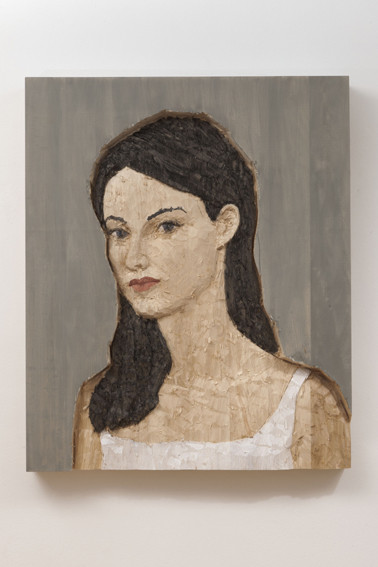Stephan Balkenhol
15 Oct - 19 Nov 2011
STEPHAN BALKENHOL
New Works
15 October -19 November, 2011
Stephan Balkenhol’s (1957, Fritzlar, Germany) sculptures of men and women, mostly carved out of one massive block of wood with polychrome surfaces, are worldwide known and appreciated. His figures are a kind of twenty-first century “everyman” – neither idealized nor individualized. A critic once described his ‘standing man’ as ‘the type of man you would never notice in a crowd.”
They can be considered as archetypes of the human figure, as they seem to copy the human uniformity. Their poses can easily be mistaken for a viewer looking at them in a museum or gallery. There is no pathos speaking out of their gestures or expressions. Balkenhol’s figures look almost alive, they look almost as somebody we know. Their gaze seems to be fixed to the near as well as to the far spot beyond reality. They do not have a specific expression though they have something which goes beyond that. As Balkenhol himself comments his figures are ”above all” “beautiful, silent, lively”. They “say a lot and nothing”.
Balkenhol’s sculptures are lodged in the temporal and stylistic continuity that extends from ancient Egypt through medieval polychrome wood statuary to Renaissance portraiture. At the same time Balkenhol’s work refers to principles of minimal art, and one may very well see it as a heritage of Ulrich Rückriem’s teaching.
StephanBalkenhol has exhibited widely in Europe and the United States, including the Musee de Grenoble, France (2010), Deichtorhallen, Hamburg (2009), Staatsliche Kunsthalle Baden-Baden Germany (2006), Museum der Moderne, Salzbourg, Austria (2006), The National Museum of Contemporary Art, Osaka, Japan (2005), Sprengler Museum, Hannover, Germany (2003), Fries Museum, Leeuwarden, Netherlands (2001), C.G.A.C. Santiago de Compostela, Spain (2001), The Hirshhorn Museum, Washington D.C., USA (1995). Balkenhol attended the Hochschule für bildende Künste in Hamburg and was taught by Ulrich Rückriem.
New Works
15 October -19 November, 2011
Stephan Balkenhol’s (1957, Fritzlar, Germany) sculptures of men and women, mostly carved out of one massive block of wood with polychrome surfaces, are worldwide known and appreciated. His figures are a kind of twenty-first century “everyman” – neither idealized nor individualized. A critic once described his ‘standing man’ as ‘the type of man you would never notice in a crowd.”
They can be considered as archetypes of the human figure, as they seem to copy the human uniformity. Their poses can easily be mistaken for a viewer looking at them in a museum or gallery. There is no pathos speaking out of their gestures or expressions. Balkenhol’s figures look almost alive, they look almost as somebody we know. Their gaze seems to be fixed to the near as well as to the far spot beyond reality. They do not have a specific expression though they have something which goes beyond that. As Balkenhol himself comments his figures are ”above all” “beautiful, silent, lively”. They “say a lot and nothing”.
Balkenhol’s sculptures are lodged in the temporal and stylistic continuity that extends from ancient Egypt through medieval polychrome wood statuary to Renaissance portraiture. At the same time Balkenhol’s work refers to principles of minimal art, and one may very well see it as a heritage of Ulrich Rückriem’s teaching.
StephanBalkenhol has exhibited widely in Europe and the United States, including the Musee de Grenoble, France (2010), Deichtorhallen, Hamburg (2009), Staatsliche Kunsthalle Baden-Baden Germany (2006), Museum der Moderne, Salzbourg, Austria (2006), The National Museum of Contemporary Art, Osaka, Japan (2005), Sprengler Museum, Hannover, Germany (2003), Fries Museum, Leeuwarden, Netherlands (2001), C.G.A.C. Santiago de Compostela, Spain (2001), The Hirshhorn Museum, Washington D.C., USA (1995). Balkenhol attended the Hochschule für bildende Künste in Hamburg and was taught by Ulrich Rückriem.

